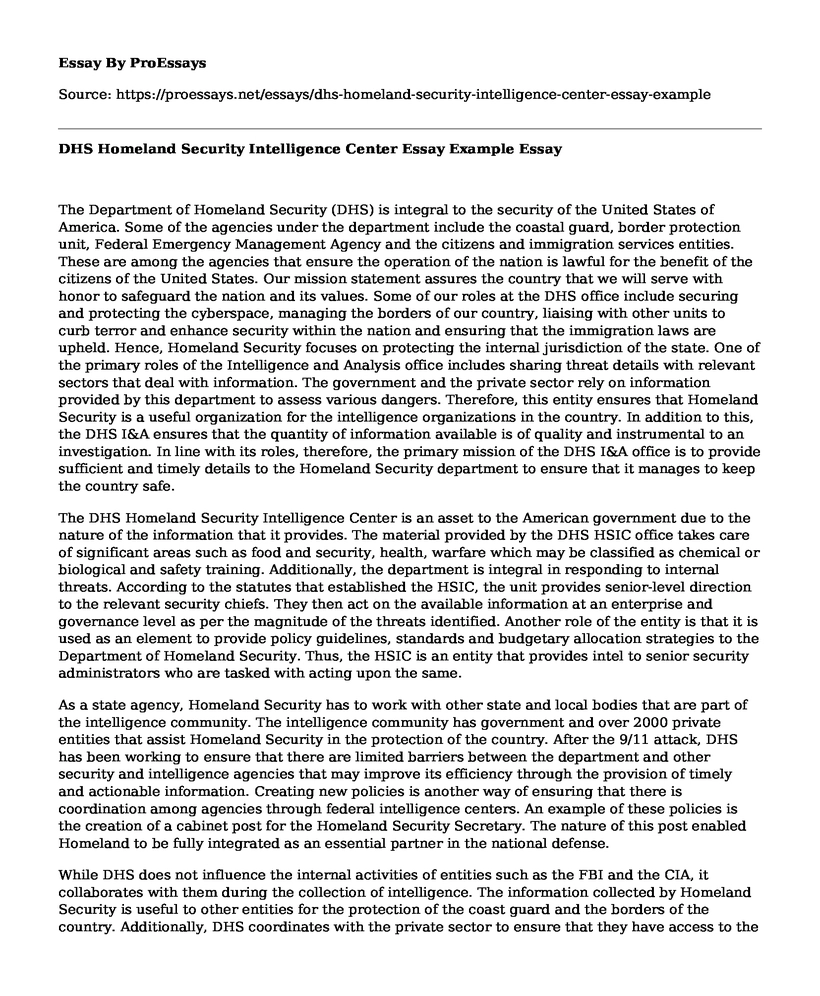The Department of Homeland Security (DHS) is integral to the security of the United States of America. Some of the agencies under the department include the coastal guard, border protection unit, Federal Emergency Management Agency and the citizens and immigration services entities. These are among the agencies that ensure the operation of the nation is lawful for the benefit of the citizens of the United States. Our mission statement assures the country that we will serve with honor to safeguard the nation and its values. Some of our roles at the DHS office include securing and protecting the cyberspace, managing the borders of our country, liaising with other units to curb terror and enhance security within the nation and ensuring that the immigration laws are upheld. Hence, Homeland Security focuses on protecting the internal jurisdiction of the state. One of the primary roles of the Intelligence and Analysis office includes sharing threat details with relevant sectors that deal with information. The government and the private sector rely on information provided by this department to assess various dangers. Therefore, this entity ensures that Homeland Security is a useful organization for the intelligence organizations in the country. In addition to this, the DHS I&A ensures that the quantity of information available is of quality and instrumental to an investigation. In line with its roles, therefore, the primary mission of the DHS I&A office is to provide sufficient and timely details to the Homeland Security department to ensure that it manages to keep the country safe.
The DHS Homeland Security Intelligence Center is an asset to the American government due to the nature of the information that it provides. The material provided by the DHS HSIC office takes care of significant areas such as food and security, health, warfare which may be classified as chemical or biological and safety training. Additionally, the department is integral in responding to internal threats. According to the statutes that established the HSIC, the unit provides senior-level direction to the relevant security chiefs. They then act on the available information at an enterprise and governance level as per the magnitude of the threats identified. Another role of the entity is that it is used as an element to provide policy guidelines, standards and budgetary allocation strategies to the Department of Homeland Security. Thus, the HSIC is an entity that provides intel to senior security administrators who are tasked with acting upon the same.
As a state agency, Homeland Security has to work with other state and local bodies that are part of the intelligence community. The intelligence community has government and over 2000 private entities that assist Homeland Security in the protection of the country. After the 9/11 attack, DHS has been working to ensure that there are limited barriers between the department and other security and intelligence agencies that may improve its efficiency through the provision of timely and actionable information. Creating new policies is another way of ensuring that there is coordination among agencies through federal intelligence centers. An example of these policies is the creation of a cabinet post for the Homeland Security Secretary. The nature of this post enabled Homeland to be fully integrated as an essential partner in the national defense.
While DHS does not influence the internal activities of entities such as the FBI and the CIA, it collaborates with them during the collection of intelligence. The information collected by Homeland Security is useful to other entities for the protection of the coast guard and the borders of the country. Additionally, DHS coordinates with the private sector to ensure that they have access to the infrastructural capacity that assesses public threats. Another way that DHS ensures coordination from state and local levels is through the creation of fusion centers in urban areas. These entities address the specific needs of jurisdiction along with its stakeholders who include the community and the local police. After their assessment, they share the information they obtain with homeland security agents. Integrating their policies with the local administration, therefore, is one of the ways that Homeland uses to facilitate coordination through the intelligence centers and community.
Conclusion
The guiding principles of Homeland Security have enabled the agency to support efforts made by other agencies to protect the United States. Through the integration of their efforts with other regional networks, the agency has gained analytic abilities to assess threats and disseminate information to intelligence agencies such as the CIA and FBI. Conclusively, the role of the DHS Intelligence and Analysis office revolves around evaluating the dangers of all forms. Additionally, the office ensures that it adheres to its mission statement to act on current information without undermining other agencies. Through the HSIC, the DHS I&A creates an environment where there is coordination between the senior administrators in the security sector. In a nutshell, the DHS Office of Intelligence and Analysis is tasked with communication, collaboration and coordination with state, local and private players to tighten the level of security.
Cite this page
DHS Homeland Security Intelligence Center Essay Example. (2022, Dec 05). Retrieved from https://proessays.net/essays/dhs-homeland-security-intelligence-center-essay-example
If you are the original author of this essay and no longer wish to have it published on the ProEssays website, please click below to request its removal:
- "Letter from Birmingham Jail" By Martin Luther King: Critical Essay
- Emerging Superpowers Are Overtaking Established Superpowers - Essay Sample
- Personal Essay for UHD MSCJ Program
- Supreme Court Rulings and Its Impact on America Essay
- The Scopes Trial: A Brief History With Documents by Jeffrey P. Moran Paper Example
- Essay Sample on John F Kennedys Murder
- Essay on US Constitution's Appropriation Bill: Effective Control of Government Funds







